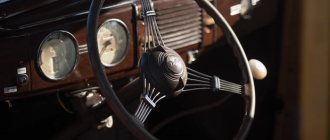What is a car
The word "car" consists of two parts. “Auto” is of Greek origin and means “oneself,” and “mobile” is Latin for “movement.”
It turns out that a car is a device that can move on its own. That is, this design must have its own propulsion mechanism - steam, gas, electric, gasoline, diesel - it doesn’t matter which one, as long as it turns the wheels with its help. This means that the first car in Russia appeared precisely when the design, invented by some craftsman, was able to move without the help of horse traction or human muscular effort.
But still, the founders of the domestic automobile industry should be considered those Russian “lefties” who were able to make their designs move without the participation of horses, and it would be unfair not to mention them.
How cars came to be: Steam cars
It's funny, but the first steam engine was built as a toy for the Chinese emperor . This happened back in 1672. The inventor is Ferdinand Verbiest, a member of the Jesuit monastic order in China. There are no reliable facts that when this car appeared, it could actually transport someone, but still, scientists consider Verbiest’s design to be the first steam car.
The history of steam engines in Europe began with the invention of Nicolas-Joseph in 1770 . It was not a personal transport, but a full-fledged heavy artillery tractor. Unfortunately, since 1865, in most European territories, a law was passed according to which a special person with a red flag and a loud pipe had to walk in front of any self-propelled vehicle on the road. This seriously disturbed ordinary people and soon the idea of a steam self-propelled gun was abandoned, turning their attention to the development of steam-powered railway transport.
In Russia there were no problems with red rags and pipes. How did the first cars appear in Russia? It all started with Kulibin, who in 1971 offered his own car for a couple. It had bearings, a gearbox, a unique flywheel and a braking system. The car only had three wheels. Unfortunately, the invention was considered only as entertainment and no one decided to invest money in it.
Cars appeared in the USA with the first automobile patent. It was received by inventor Oliver Evans in 1789. Evans' self-propelled vehicle was received very well by the public. Among other things, his car could move both on land and on water.
The origins of the domestic automotive industry
The history of the first car in Russia began on November 1, 1752 in St. Petersburg. There, for the first time, a four-wheeled carriage was shown, which was capable of moving without the help of horses and other draft animals. It was a steel mechanism driven by a gate of a special design and the muscular efforts of one person. The stroller could carry, in addition to the driver, two more passengers, and at the same time moved at speeds of up to 15 km/h. The designer of the car was an ordinary self-taught serf peasant who lived in the Nizhny Novgorod province - Leonty Lukyanovich Shamshurenkov. The mechanism he created, of course, cannot be considered a car, but it was no longer a cart.
The Russian designer Ivan Petrovich Kulibin was much closer to our usual vision of the car.
Kulibin crew
The design, invented by Kulibin, consisted of a three-wheeled chassis on which a double passenger seat was installed. The driver himself, standing behind this seat, had to press alternately on two pedals connected to the wheel rotation mechanism. Kulibin's crew is especially notable for the fact that it contained almost all the basic design elements of the cars of the future, and it was he who first used gear changes, a braking device, bearings and a steering wheel in his wheelchair.
The appearance of the first car in Russia
In 1830, K. Yankevich, who was a recognized master of gun carriages, together with his assistants assembled the “Bystrokat” - a self-propelled wheeled vehicle with a steam engine. The engine had a device based on the designs of steam power units by I. I. Polzunov, M. E. Cherepanov and P. K. Frolov. According to the inventor, pine charcoal was to be used as fuel.
The design was a covered wheeled carriage, which provided, in addition to space for the driver, also space for passengers.
However, the mechanism turned out to be very cumbersome and difficult to operate. Therefore, the design of the machine turned out to be unviable. Nevertheless, it was the first domestic car in Russia that could truly be considered a real self-propelled machine with a steam engine.
The appearance of an engine capable of running on gasoline gave impetus to the further development of automotive technology, since it was this engine, thanks to its relatively compact size, that could become the source of driving force for future cars.
Who and when created the first car?
In fact, as with most human inventions, it is difficult to answer who exactly is the creator of the first car. There were many developments, many scientific minds invented something similar to a car. Developments were carried out in parallel. Some were more enterprising and declared themselves to be the inventor of the car, while others resigned themselves to seizing fame.
And what exactly is a car? Use modern definition? Should self-propelled vehicles powered by a steam engine be taken into account, or should the presence of an internal combustion engine in the device be considered a mandatory feature?
Probably everyone should answer these questions for themselves. Nevertheless, it is worth delving into history and tracing how society came to use cars, at least the very first ones that were put into mass production.
The first cars in Russia with internal combustion engines
According to some historians and researchers, the first car with an internal combustion engine was designed in 1882 in a small town on the Volga. The authors of the machine were engineers Putilov and Khlobov. However, no official documents reliably confirming this fact were ever found. Therefore, it is believed that the very first cars in Russia equipped with liquid fuel engines were imported from abroad.
In 1891, Vasily Navorotsky, who worked as the editor of one of the Odessa newspapers, imported the French Panhard-Levassor car into Russia. It turns out that for the first time in our country, residents of Odessa saw a gasoline car.
Progress in the form of gasoline cars reached the capital of the Russian Empire only 4 years later. On August 9, 1895, St. Petersburg saw the first gasoline-powered self-propelled car. A little later, several more such cars were brought to the capital.
Apparently, the appearance of imported samples on the world market prompted domestic design engineers to act.
Engine capacity
A piston engine can have on average from 3 to 8 cylinders, each of which has a combustion chamber. The engine volume is the sum of the working volumes of these cylinders. The larger the volume, the more air and fuel in total can enter the combustion chambers, respectively, the more powerful the car.
For urban conditions, the optimal volume is 1.4 - 2.0 liters. For frequent driving on the highway - 2.0 - 2.5 liters.
Fuel consumption directly depends on engine size.
Important
It is better for a beginner to choose the average option – 1.8 – 2.0. As for hybrids, the volume of the gasoline engine may be smaller - 1.3-1.6 liters, because The car gets the missing power from the electric motor.
The first Russian car with an internal combustion engine
In 1896, at the Nizhny Novgorod exhibition, a completely domestically assembled car equipped with a gasoline engine was presented for public viewing. The car was named: “Car of Frese and Yakovlev”, in honor of its designers - E. A. Yakovlev and P. A. Frese. The Yakovlev plant manufactured the transmission and engine for the car. The chassis, wheels and the body itself were produced at the Frese factory. However, it cannot be said that the appearance of the Russian car was solely the merit of Russian engineers.
The first Russian electric car
3 years after the release of Yakovlev and Frese's car, in 1899 the first electric motor was born. It was invented by Ippolit Romanov. The car of a nobleman from Odessa with an electric motor was faster and heavier than a gasoline one. Its maximum speed was 37 km per hour, but it weighed 750 kilograms - almost half of this weight was occupied by the battery.
However, there was one more “but”: that same battery was disposable and only lasted for 65 kilometers. Romanov's brainchild never went into mass production - there was not enough financial support for the project, although the inventor received a government order for 80 models.
Western model for a Russian car
Most likely, Frese and Yakovlev used the experience of the German designer Benz in the manufacture of their car, and his Benz-Victoria car was taken as a standard, which they saw while visiting an exhibition in Chicago in 1893, where it was exhibited, both structurally and in its own way. In appearance, the domestic car was very reminiscent of the German model.
True, it is worth paying tribute to the Russian engineers, the car was not a 100% copy of its foreign counterpart. The chassis, body and transmission of the domestic car were significantly improved, which was emphasized in the press of that time, which closely followed new products in the field of discoveries and inventions.
Documented parameters of the domestic machine, as well as drawings, have not been preserved. All judgments about the car are based on descriptions and photographs preserved from that time. In fact, it is not even reliably known how many cars of this series were produced. But in any case, these were the first cars in Russia, with which mass production of Russian cars began.
The finish line for the first petrol car
The story of the car assembled by Frese and his companion ended quickly. In 1898, the engineer and industrialist Yakovlev died, which, in fact, was the beginning of the end for the first-born of the domestic automobile industry. The death of a companion forced Frese to purchase engines for cars abroad, which, of course, was extremely unprofitable for him. In 1910, he sold all established production to the Russian-Baltic Plant.
Nevertheless, the fact that the first domestically produced cars in Russia appeared thanks to Frese and Yakovlev is forever inscribed in the history of the domestic automotive industry, and RBVZ became the next step in the development of Russian car production.
How cars appeared: Internal combustion engines
Despite the fact that there had been attempts to create a car with an internal combustion engine before, the first actually working model of the car was invented by Karl Benz in 1885 . He received a patent for his invention in January 1886. In the same year, the first mass production of personal cars began in history. This was facilitated by a serious advertising campaign, during which Karl and his wife Bertha even made long-distance trips in their car.
Three years later, in 1889, Wilhelm Maybach and Schottlieb Daimler produced their first car . The car was originally intended to be a self-propelled vehicle and quickly became popular among the bourgeoisie and intelligentsia.
It was from this moment that humanity entered the era of total automobile production. Soon cars would fill the streets of the United States, Europe and the Russian Empire, but for a long time they would be considered more of a luxury than a means of transportation - contemporaries of the first cars believed that it was better to travel by trains and ships.
And the era of aircraft construction was coming... The material was prepared specifically for PF
Russian-Baltic Carriage Works (RBVZ)
The first car brand in Russia received the official name “Russo-Balt”. Under it, a year before the purchase of the Frese factory, in the summer of 1909, the company produced the first car of its own production.
Cars of this brand have proven themselves to be durable and very reliable, which was confirmed by the success of cars that participated in long runs, car competitions and even in international rallies. There is a documented fact that one of the cars, produced in 1910 under the symbol “S-24”, covered 80 thousand km over 4 years of operation without serious breakdowns or repairs. Even the imperial garage in 1913 placed an order for two models of cars, “K-12” and “S-24”.
60% of the Russian army's vehicle fleet consisted of Russo-Balt vehicles. Moreover, not only vehicles were purchased from the plant, but also chassis for use on armored cars.
An important fact is that the plant manufactured almost all parts, components and mechanisms in-house. Only tires, ball bearings, and oil pressure gauges were purchased abroad.
RBVZ produced cars in large series, and within each of them there was almost complete interchangeability of components and parts.
In 1918, the enterprise was nationalized and continued its history as an armored tank factory.











